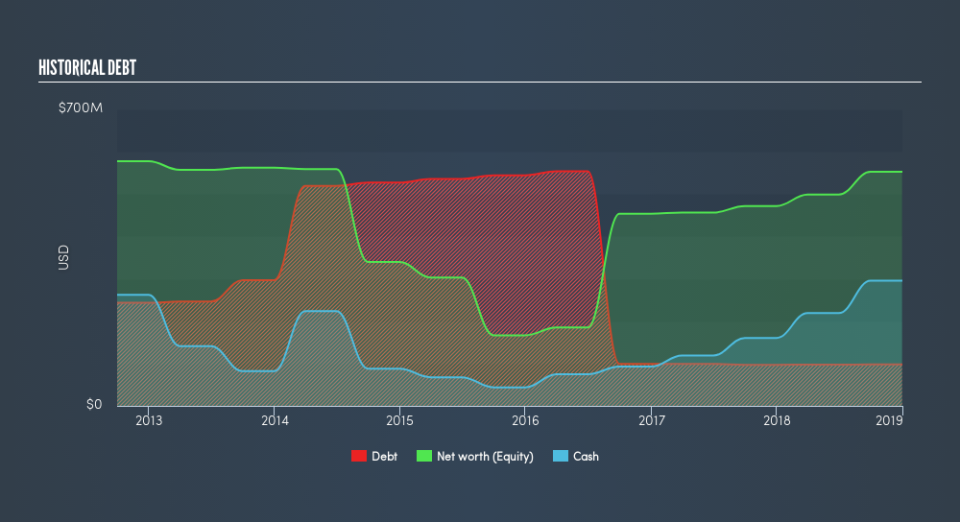Does Gulf Keystone Petroleum (LON:GKP) Have A Healthy Balance Sheet?

Howard Marks put it nicely when he said that, rather than worrying about share price volatility, 'The possibility of permanent loss is the risk I worry about... and every practical investor I know worries about.' So it might be obvious that you need to consider debt, when you think about how risky any given stock is, because too much debt can sink a company. Importantly, Gulf Keystone Petroleum Limited (LON:GKP) does carry debt. But the real question is whether this debt is making the company risky.
Why Does Debt Bring Risk?
Generally speaking, debt only becomes a real problem when a company can't easily pay it off, either by raising capital or with its own cash flow. Ultimately, if the company can't fulfill its legal obligations to repay debt, shareholders could walk away with nothing. However, a more common (but still painful) scenario is that it has to raise new equity capital at a low price, thus permanently diluting shareholders. Having said that, the most common situation is where a company manages its debt reasonably well - and to its own advantage. When we examine debt levels, we first consider both cash and debt levels, together.
Check out our latest analysis for Gulf Keystone Petroleum
How Much Debt Does Gulf Keystone Petroleum Carry?
As you can see below, Gulf Keystone Petroleum had US$97.8m of debt, at December 2018, which is about the same the year before. You can click the chart for greater detail. However, it does have US$295.6m in cash offsetting this, leading to net cash of US$197.8m.
How Healthy Is Gulf Keystone Petroleum's Balance Sheet?
According to the last reported balance sheet, Gulf Keystone Petroleum had liabilities of US$85.6m due within 12 months, and liabilities of US$120.4m due beyond 12 months. Offsetting these obligations, it had cash of US$295.6m as well as receivables valued at US$66.3m due within 12 months. So it can boast US$155.8m more liquid assets than total liabilities.
This surplus suggests that Gulf Keystone Petroleum is using debt in a way that is appears to be both safe and conservative. Because it has plenty of assets, it is unlikely to have trouble with its lenders. Simply put, the fact that Gulf Keystone Petroleum has more cash than debt is arguably a good indication that it can manage its debt safely.
Better yet, Gulf Keystone Petroleum grew its EBIT by 232% last year, which is an impressive improvement. If maintained that growth will make the debt even more manageable in the years ahead. When analysing debt levels, the balance sheet is the obvious place to start. But ultimately the future profitability of the business will decide if Gulf Keystone Petroleum can strengthen its balance sheet over time. So if you're focused on the future you can check out this free report showing analyst profit forecasts.
But our final consideration is also important, because a company cannot pay debt with paper profits; it needs cold hard cash. Gulf Keystone Petroleum may have net cash on the balance sheet, but it is still interesting to look at how well the business converts its earnings before interest and tax (EBIT) to free cash flow, because that will influence both its need for, and its capacity to manage debt. Happily for any shareholders, Gulf Keystone Petroleum actually produced more free cash flow than EBIT over the last two years. That sort of strong cash conversion gets us as excited as the crowd when the beat drops at a Daft Punk concert.
Summing up
While we empathize with investors who find debt concerning, you should keep in mind that Gulf Keystone Petroleum has net cash of US$198m, as well as more liquid assets than liabilities. And it impressed us with free cash flow of US$138m, being 203% of its EBIT. So is Gulf Keystone Petroleum's debt a risk? It doesn't seem so to us. Above most other metrics, we think its important to track how fast earnings per share is growing, if at all. If you've also come to that realization, you're in luck, because today you can view this interactive graph of Gulf Keystone Petroleum's earnings per share history for free.
When all is said and done, sometimes its easier to focus on companies that don't even need debt. Readers can access a list of growth stocks with zero net debt 100% free, right now.
We aim to bring you long-term focused research analysis driven by fundamental data. Note that our analysis may not factor in the latest price-sensitive company announcements or qualitative material.
If you spot an error that warrants correction, please contact the editor at editorial-team@simplywallst.com. This article by Simply Wall St is general in nature. It does not constitute a recommendation to buy or sell any stock, and does not take account of your objectives, or your financial situation. Simply Wall St has no position in the stocks mentioned. Thank you for reading.

 Yahoo Finance
Yahoo Finance 
